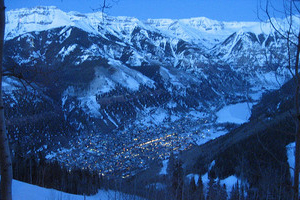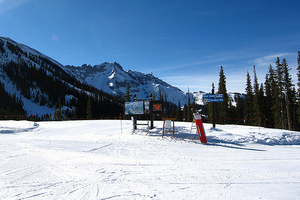I put on my hat and gloves, apply the sunblock on my face and ears, dab some chapstick on my lips and knock back a couple of Advil. Extra strength. “Are you feeling sick?” My husband, Thibault Mayor, looks at me with concern as we head out the door. No, I don’t have a headache or any other kind of ache. Not yet, anyway. But I’ve signed up for my first snowboarding lesson so I may as well get ahead of the pain that’s sure to come my way.
We’re staying in Mountain Village, an intimate alpine enclave a short gondola ride up from Telluride, Colorado. It’s bright and early on Saturday morning as glittery snow flakes twirl in the thin air and the square outside Mountain Lodge, our slope-side hotel, buzzes with activity. Workers shovel away the snow that gathered overnight in front of the coffee shops and restaurants, couples in matching ski suits get their lift tickets and hip thirty-something mom and dads help their young kids with their tiny snowboards. Suddenly, I can’t help but feel that I’m a little too old to learn to snowboard.
“You’re gonna do great,” says Thibault as if reading my mind. At the bunny slope where the beginner class has already assembled we say a quick good bye and he shuffles off to the lift line—though “line” is really a misnomer when there are rarely more than a handful of people in front of you.
We had heard from friends who’d been to Telluride Ski Resort about its legendary feature—no lift lines—but hadn’t really believed them until now.
I meet my spark plug of an instructor, a British expat named John, and I quickly admit that I’m more of a beach person. I can’t deny that I’ve been attracted to the energy and playfulness of snowboarding for a while but somehow never quite saw myself on a snowboard. Since getting married, however, my husband who is from Switzerland and learned to ride in the Alps has raved so much about the sport that I finally decide to give it a shot.
Class gets underway with a few downward dogs and wrist stretches while we listen to the wise words from our instructor—things like don’t look down and bend your knees. We spend the first hour of class learning the basics, like scooting carefully down the hill in what’s called a sideslip. Then we gently glide back and forth across the slope to master the falling leaf traverse. We’re giving each other high fives and grinning broadly. “Pretty easy, innit?” says John. “You guys are ready to start making turns,” he says to the eager students. And trouble ensues.
What we’re basically asked to do is point our boards down the fall line—aka towards hell—then shift our weight and rotate our bodies from one edge of the board to the direction we want to travel. With our instructor demonstrating the move, it looks like child’s play. But when my turn comes up I experience a momentary panic attack as the board noses downhill and I start to pick up speed. To braze myself for what seems like inevitable death I move my weight onto my back foot—exactly what you should not do—catch an edge and collapse on my face.
John explains that we must keep our center of gravity low, our backs straight, our knees bent. “You control the board with your powerhouse,” John says motioning to an invisible point somewhere between his belly button and his tailbone. “Look where you want to go,” he tells me when I lead with my chin.
We’re all parked on our butts, feeling simultaneously frustrated and amazed as other snowboarders flash past us, making turns like nobody’s business. There’s abundant evidence that turns can be done. Just not by us, specifically. What we do with amazing skill is fall.
“Don’t fight the mountain,” says John to no one in particular. “To paraphrase the Clash: you fought the mountain and the mountain won.” Uh, OK.
A group of beginner skiers is practicing nearby. And when they wipe out—with skis and poles jangling off every which way—you can’t help but feel a little sorry for them. Their spills look awkward and embarrassing while one of ours is basically a resounding smack into the snow. Get up, splat. Get up, splat.
Splat. I’m down again, this time on my back and I can’t honestly say what’s more exhausting, the getting up or the falling down. And yet, in the distance above us I can spot a group of snowboarders carving gracefully through the trees and I think, I want to do that. It’s inspiring but also demoralizing because I’m on a freaking bunny slope as challenging as the roof of a Volkswagen Beetle.
By 4 p.m. the lesson is over and I’m so tired, my legs shaky, my forearms sore that I consider crawling back to the hotel where more Advil awaits by the bathroom sink.
Back at the Mountain Lodge’s open-air hot tub, Thibault and I reconvene for a good long soak and share stories about out first day. As the sun sets behind the mountains, the sky becomes a psychedelic canvas of pinks and blues. It is so cold the wet curls that fall on my shoulder have turned to icicles. Once we get back to our room, Thibault pulls out a freshly printed map that reflects his mountain experience thanks to a GPS Ski Tracking armband he wore the entire day. The personalized map includes the number of tracks, terrain difficulty, vertical feet and speed, time and distance he boarded and even how many calories he burned. “I bet falling on my butt and getting up every 20 seconds or so burns a hell of a lot of calories,” I say hopefully.
Later at Allred’s, a chic restaurant perched some 10,500 feet above sea level, I feel zero guilt about ordering a tender and flavorful Colorado lamb served with preserved mint, a garam masala cucumber yogurt and fig ginger puree. The restaurant offers a bird’s eye view of Telluride. The quaint mountain town is eight blocks long and 12 blocks wide and is soaked in historic charm, is devoid of chain restaurants and is cradled by the greatest concentration of 14,000-foot peaks in North America.
We do a little exploring the next day at breakfast and are immediately charmed by Telluride’s colorful Victorian houses and mining town-era storefronts featuring designer mountain fashions and pretty silver jewelry. Thanks to the city’s free transportation system, an environmentally friendly gondola whisks us back up to Mountain Village in 13 minutes, just in time for my lesson.
The amazing thing about snowboarding is how quickly your body actually picks it up when the brain decides to trust gravity instead of, well, fighting the mountain. Before I know it, there I am making one blissful turn after another. With a loose and relaxed stance, I find that my board follows exactly in the direction that my eyes focus on. Now, why was this so difficult just 24 hours earlier?
“There are some things about snowboarding that you can’t really teach,” says John in his most Zen tone. He talks about being one with the mountain, about the fine line between hardly trying and trying too hard. All I know is that I finally get to experience the lift lines, or lack thereof, at Telluride when we head to the top of the mountain.
Momentum. It’s a wonderful thing and I’m thrilled to discover that when it takes over, snowboarding gets a lot easier. Indeed, the only times I do fall are when riding through flatter terrain and getting off the lifts. With every fast and spill-less run my confidence soars and my goofy smile becomes a series of spine-tingling giggles. I had heard about snowboarding’s steep learning curve but I never imagined the thrill of flying down a mountain, riding through fresh powder with the wind in my face.
On my last run, I’m feeling a bit cocky as I seamlessly link another sequence of turns and arrive safely at the lodge. Thibault points to a posse of teenage ruffians pulling off tricks I couldn’t even name, never mind imitate. Not that I would want to. I’m happy to say that I can finally snowboard and figure that riding down the blue or even black trails is not impossible, even on my next trip. Just in case, I’ll be sure to pack some Advil.



